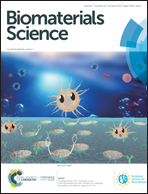Antibody-guided nanomedicines as novel breakthrough therapeutic, diagnostic and theranostic tools
Abstract
Recent advances in nanotechnology, such as the development of various types of nanoparticles and hybrid nanomaterials, have revolutionized nanomedicine. The small size, customizable surface, enhanced solubility, and multi-functionality endow the nanoparticles with an ability to interact with complex cellular and biological functions in new ways. Furthermore, these systems can deliver drugs to specific tissues and provide a targeted therapy. For this purpose, different categories of molecules, particularly antibodies, have been used as ligands. Antibody-conjugated nanomaterials can significantly enhance the efficiency of nanomedicines, especially in the field of cancer. This review is focused on three major medical applications of antibody-conjugated nanomaterials, namely, therapeutic, diagnostic and theranostic applications. To provide comprehensive information on the topic and an overview of these hybrid nanomaterials for biomedical applications, a brief summary of nanomaterials and antibodies is given. Moreover, the review has depicted the potential applications of antibody-conjugated nanomaterials in different fields and their capabilities to empower nanomedicine, particularly in relation to the treatment and detection of malignancies.



 Please wait while we load your content...
Please wait while we load your content...